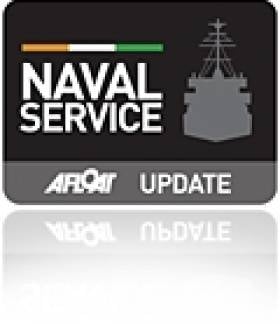Displaying items by tag: L.E. Roisin
French Registered Vessel Detained off Castletownbere
#FISHERY DETENTION – A French registered fishing vessel, was detained by the Naval Service OPV L.É. Roisin (P51) approximately 170 nautical miles West of Castletownbere, Co. Cork last night.
The detention was in relation to alleged breaches of technical fishing regulations. The detained vessel was to be escorted by the offshore patrol vessel to Cork, and then transferred to the Gardaí.
Last week the navy detained an Irish registered vessel on the same grounds and also for alleged under-recording of catch, in waters 60 miles off Roches Point, as previously reported on Afloat.ie
This latest detention by the Naval Service raises the number to 16 vessels so far in 2012.
Dublin Bay Ceremonies for OPV L.E. Roisin
#COMMAND CHANGEOVER CEREMONY– The offshore patrol vessel OPV L.E. Róisín (P51) arrived to Dun Laoghaire Harbour today for the official reopening of the town's maritime museum and follows a changeover command ceremony held on board the vessel in Dublin Port last Friday, writes Jehan Ashmore.
At the ceremony the Lord Mayor of Dublin, Cllr Andrew Montague along with the Flag Officer Commanding the Naval Service, Commodore Mark Mellett presided over the command handover along Sir John Rogersons Quay.
This saw Lieutenant Commander Terry Ward, who is originally from Dublin, take over command from Lieutenant Commander Peter Twomey of the OPV which was adopted by the City of Dublin in 2000 and has maintained a strong connection with the capital.
The OPV departed on Sunday on a short patrol in the north Irish Sea until returning to Dublin Bay this morning. She berthed at the East Pier in Dun Laoghaire Harbour where at the nearby National Maritime Museum of Ireland, senior officer ratings and a party of 20 crew members made a guard of honour for President Michael D. Higgins who officially reopened the €4m renovated building.
The President is the supreme commander in chief of the Defence Forces and also is patron to the Maritime Institute of Ireland which was established in 1941 and runs the maritime museum in Dun Laoghaire.
Naval Service OPV On Visit to Russia and Baltic States
Since Tuesday the offshore patrol vessel (OPV) has been berthed in the Baltic city of St. Petersburg. Her naval officers laid a wreath at the Piskarevskoye Memorial Cemetery. Also visited was the Central Naval Museum and the naval cruiser Aurora, where one of the first incidents of the 'October' Russian revolution took place in 1917.
Irish Ambassador to Russia Philip McDonagh boarded the L.E. Roisin yesterday to highlight Irish-Russian bi-lateral relationships and co-operation between the two countries in areas of economic, culture, education and tourism. In the first-half of 2010 bi-lateral trade with Russia was up 66% and St. Petersburg is the most important economic centre after Moscow.
The trade mission follows last year's visit of president Mary McAleese who became the first Irish head of state to visit Russia. On her visit which included St. Petersburg, she signed a protocol on partnership and co-operation between the Russian city and Dublin during the third St. Petersburg International Innovation Forum.
In March of this year representatives from St. Petersburg took part in the Russian Culture Festival in Dublin. Three months later in July, the Irish capital was visited by the Russian Naval destroyer Admiral Chabanenko (650), the flagship of the countries Northern Fleet. For more on that visit of the Udaloy –II class destroyer click HERE.
L.E. Roisin is not the first Irish Naval Service vessel to visit the Russian Federation as this accolade goes to the flagship L.E. Eithne (P31) which called to St. Petersburg in 2003.
- Irish Naval Service
- Dublin Port
- naval service
- Ports and Shipping News
- LE Eithne
- Naval Visits
- Navy News
- Irish navy news
- L.E. Roisin
- LE Roisin
- Irish OPV vessels
- St. Petersburg trade mission
- IrishRussian trade
- Irish Ambassador to Russia
- President Maru McAleese
- Irish trade delegation to Russia
- Lt Cdr Peter Twomey
- Philip McDonagh
- Adi Roche
- Chernobyl Children's Project


























































